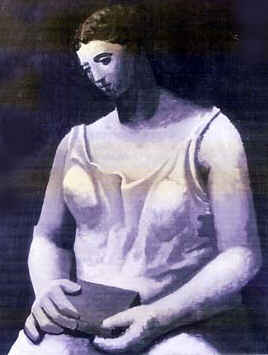— Turner was an
English landscape painter who is renowned especially for his dynamic treatment
of natural light effects in land and marine subjects. His work is of direct
importance in the development of impressionism.
Turner was born in London and educated at
the Royal Academy of Arts. At the age of 15 he exhibited his paintings at
the academy and continued to show his work there until 1850. He was elected
an associate of the academy in 1799 and a full member three years later.
He traveled widely throughout his career, extensively touring England and
Scotland and later France, Switzerland, and Italy. In 1807 he became professor
of perspective at the Royal Academy and in 1845 was appointed deputy professor.
Turner's early paintings were predominantly watercolors and his subjects
mostly landscapes. By the late 1790s he had started exhibiting his first
oil paintings, eventually transferring to the oils the same vibrance of
color that had proved so successful in his watercolors. His mature work
falls into three periods.
During the first period (1800-20) Turner
painted many picturesque mythological and historical scenes in which the
coloring was subdued and details and contours were emphasized. He was influenced
by the 17th-century French landscape painter Claude
Lorrain, notably in the use of atmospheric effects, as in The Sun
Rising Through Vapor (1807), and in the treatment of architectural forms,
as in Dido
Building Carthage (The Rise of the Carthaginian Empire) (1815).
Turner also produced numerous engravings for his unfinished collection Liber
Studiorum (1806-19).
The paintings of the artist's second period
(1820-35) are characterized by more brilliant coloring and by diffusion
of light. In two of Turner's best works, Bay
of Baiae with Apollo and the Sibyl (1823) and Ulysses
Deriding Polyphemus (1829), his use of light lends radiance to the
colors and softens architectural and topographical forms and shadows. During
this period he also executed a number of illustrations for books on topography
and a collection of watercolors depicting Venetian scenes.
Turner's artistic genius reached its culmination
during his third period (1835-45). In such works as Snow
Storm: Steam Boat Off a Harbor's Mouth (1842), Peace
– Burial at Sea (1842), and Rain,
Steam and Speed - The Great Western Railway (1844), he achieved
a vibrant sense of force by presenting objects as indistinct masses within
a glowing haze of color. Some of the forces represented are the strength
of the sea and the rhythm of rain. Other famous works of this period include
The
Fighting Téméraire (1839), The Sun of Venice Going to Sea
(1843), and The
Approach to Venice (1844). Turner died in London.
— Turner was only fourteen years old when
he was admitted to the Royal Academy Schools. He started his career by painting
watercolors and producing mezzotints under the strong influence of John
Robert Cozen's work. Then, in 1796, he launched into oil painting, working
in the neoclassical manner of Richard Wilson and Nicolas
Poussin, with results that found wide acclaim. He exhibited his first
picture Fishermen
at Sea (1796) in the Royal Academy exhibition in 1796. He was elected
an Associate in 1799 and in 1802 a full member of the Royal Academy. Turner
was one of the most prolific painters of his time. He traveled extensively
in England, Scotland and Ireland, and also on the Continent (France, Belgium,
Holland, Germany, Italy).
In 1802, he visited Paris for the first
time, where he studied the Old Masters in the Louvre, above all Dutch seascapes
and Claude Lorrain's compositions, which lastingly influenced him. Turner's
first private showing, at his own house, took place in 1804. During this
period, thanks to the increasing concentration on the atmospheric effects
of light, his original style began to evolve, a process that culminated
during trips to Italy between 1819 and 1829.
Like the works of Constable,
Turner's seemingly effortless watercolors and oil sketches were based on
impressions of nature. But his perception of the world differed vastly from
Constable's. Turner's pictures transcend ordinary appearances, conveying
a visionary sense of the forces at work in the universe.
In his atmospheric depictions of shipwrecks and
natural disasters such as The Shipwreck
(1805), Snow
Storm: Hannibal and His Army Crossing the Alps (1812), A Storm
(Shipwreck) (1823), Shipwreck
off Hastings (1825), Fire at
Sea (1835), Snow
Storm - Steam-Boat off a Harbour's Mouth (1842) reality and fantasy
merge and color is used to metaphorically evoke the power of natural phenomena.
By abandoning form or merely outlining it, Turner lent color autonomy and
endowed it with a power of its own. This achievement was to be especially
influential on XX century art. Turner's other best works are The Battle
of Trafalgar, as Seen from the Mizen Starboard Shrouds of the Victory
(1808), The
Decline of the Carthaginian Empire (1817), Childe
Harold's Pilgrimage (1823), A Ship
Aground (1828), The Fighting
Temeraire Tugged to Her Last Berth to Be Broken up (1838), Peace
- Burial at Sea (1842), The Dogana,
San Giorgio, Citella, From the Steps of the Europa (1842), Light
and Color (Goethe's Theory) - The Morning after the Deluge - Moses Writing
the Book of Genesis (1843), Rain,
Steam and Speed - The Great Western Railway (1844).
— MORE
— LINKS
— The
Unpaid Bill (The Dentist Reproving his Son's Prodigality)
(1808, 59x80cm) — The
Grand Canal, Venice (1830) — View
of Kenilworth Castle (1830) |
 ^
2002 Return of Picasso painting looted by the Nazis
is demanded.
^
2002 Return of Picasso painting looted by the Nazis
is demanded.